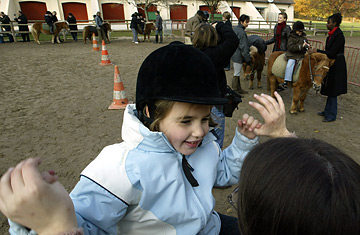
A teacher plays with an autistic child during a training session in an equestrian club in Paris, 2003.
From the earliest months, a healthy baby engages in an astonishing range of social behaviors. Most will begin smiling back at a loved one in the first four months of life. Most will follow a parent's gaze with their own eyes by eight months. Most will also study a caregiver's facial expressions and mimic exhibits of fear, surprise or delight with their own tiny features. They will babble a conversation back and forth by nine months, respond to their names by 10 months, and begin to point to a desired toy or treat by around a year.
But some babies won't do these things, and a pattern of such deficits can be an early sign of autism. Despite these and many other early tip-offs, autism spectrum disorders (ASD) are rarely diagnosed before age 3. More subtle forms, such as Asperger's Syndrome, may not be recognized until the child begins school.
The American Academy of Pediatrics (AAP) would like to change this. At its annual meeting, held in San Francisco on Monday, the AAP released two reports: one aimed at helping pediatricians recognize autism spectrum disorders — in all their varieties — by age 2 and the other at providing guidance for early intervention. At the same time the AAP formally recommended that all pediatricians routinely screen for autism at ages 18 months and 2 years and announced it was making a new "toolkit" of diagnostic information available to all its members — for about $70.
The announcements came in response to a growing consensus that autism can be picked up very early in life and that early intervention holds the best promise for helping affected children. It is also an admission that, despite an explosion of news on autism in recent years, pediatricians are not currently doing an optimal job of identifying the spectrum of conditions now believed to affect as many as 1 in 150 children. A 2004 survey of primary care pediatricians found, for instance, that only 8% were routinely screening for autism, even though 44% said they saw at least 10 kids with autism in their practice.
The AAP had already recommended routine screening for autism in 2006, but the new recommendations are more specific and backed by more information for practitioners. Two screenings are needed — one at 18 months and one at 24 months, explains Dr. Scott Meyers, who authored one of the reports, because about a quarter of children with ASD appear to develop normally at first and then regress — losing early language and social behavior — sometime between 15 and 24 months.
Meyers, a neurodevelopmental pediatrician with Geisinger Health System in Danville, Pa., wrote the AAP's new survey of research on managing the care of children with autism. His report supports intensive behavioral and speech therapy — at least 25 hours a week — beginning as early as possible. But, he concedes, there's a lack of rigorous, randomized research on what interventions work best. The report encourages pediatricians not to condemn parents who turn to alternative therapies, but to help guide them toward the safest and best-researched approaches. "Don't just dismiss it out of hand," says Meyers, "It's important to keep communication open and respect the fact that parents are going to be looking for answers."
